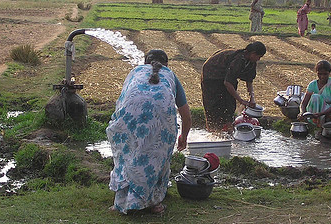Difference between revisions of "Biogas-fueled pump"
From Akvopedia
(→Reference manuals, videos, and links) |
|||
| Line 1: | Line 1: | ||
| + | [[Image:biogas pump.jpg|thumb|right|250px|Biogas irrigation pump. Photo: [http://www.flickr.com/photos/djfulford/3156710354/in/set-72157612011013426 d.j. fulford.]]] | ||
==Suitable conditions== | ==Suitable conditions== | ||
Revision as of 07:35, 29 August 2012

Biogas irrigation pump. Photo: d.j. fulford.
Contents
Suitable conditions
| Advantages | Disadvantages |
|---|---|
| - Makes good use of organic wastes. You can obtain fuel from sewage sludge and animal slurries first, and prevent runoff and methane emissions at the same time – and you still get fertiliser at the end of the process. - Is a clean, easily controlled source of renewable energy. |
- Most practical to be generated and used at the source of the waste. This is because the energy needed to compress the gas for transport, or convert it into electricity is excessive, reducing the efficiency of biogas energy production. - For safety, basic precautions must be adhered to. |
Reference manuals, videos, and links
- Video: Biogas plant construction in Kampala, Uganda.
- Video: Anaerobic methane digester how to, including biogas scrubbing.
- Video: Biogas: how it works.
South Asia
- Video: Biogas Driven Irrigation Pump. The diesel pump has been converted to a Biogas driven pump by the farmer, Purushottambhai Patel. Purushottambhai is from Shekhadi village in Petlad Taluka, Anand District (Gujarat). English subtitles.
- Video: Developing Biogas Plant.wmv in Polasong and Belguri village Kamrup district, Assam, INDIA, geographical coordinates N26 06.441 E92 04.290. The soil type is sandy loam to clay.
- Video: KITCHEN WASTE TO BIOGAS - BENEFICIARY STATEMENT. Biotech-India.org
- Video: Biogas project of Bangladesh. The success & problems of Bio gas project in Bangladesh. Not in English.
- Video: Bio Gas in Nepal. The biogas initiative in Nepal. In English and with English subtitles in some sections.
- Video: Biogas-powered Electrictal Generator in Myanmar. Brief video shot at the Myanmar Baptist Convention agricultural training center near Yangon in early March. Biogas brewed from wastes produced by a few hogs located just above this location is piped to an electric generator. Each day, there's enough biogas produced to power the 3 kw generator for 45 minutes in the morning and another 45 minutes in the evening. The generator, in turn, powers lights as well as an electric pump that extracts water from the center's well for storage in an elevated tank. The stored water flows by gravity to spigots throughout the farm. Saw Hei Moo, who directs the project, estimates that the biogas system costs about $350 with the generator running around $300. Toss in perhaps another $100 for pipe, cylinders and other types of essential apparatus.
- Video: Efficient Biogas digesters built by Wasandi BioSolar Company. Wasandi Biosolar (Pvt) Ltd makes Biogas digesters, and has worked for the last few years on making effiecient Biogas digesters. This type of digester is much cheaper to build, lasts longer, easier to repair, gives more gas, and can be built in 2 to 3 days at any place. We gaurantee our digesters for ten years, but our digesters will be good and working for more then 30 to 40 years. Biogas is the cleanest fuel available. If you are intrested in getting Biogas for your home or village, we can make a digester of any size. For details visit our web site: www.wasandi.com
